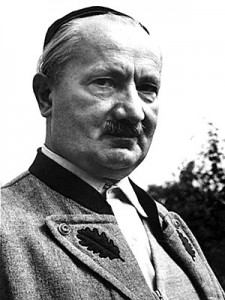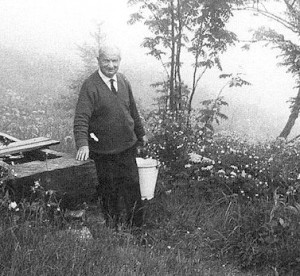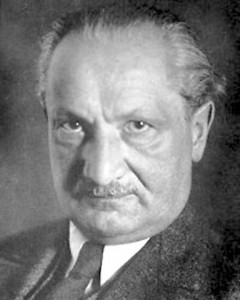 |
| Heidegger dressed as a Tyrolean peasant |
Martin Heidegger, says philosopher Richard Rorty, was a resentful, ungenerous, disloyal, and deceitful man. He was also an enthusiastic member of the Nazi party from 1933 until it was disbanded by the Allies in 1945. Immediately after the war, because of his Nazi involvement, he was stripped of his professorial rights, which were not restored until 1951. To the end of his life, for the thirty-one years that he continued to live and write, he was unrepentant, silent, and evasive about his relation with the Nazi state.
Heidegger published Being and Time, arguably the single most influential philosophical text of the twentieth century, in 1927. After the war, in his forced retirement, he lived in a small house in the rural town of Todtnauberg and became — I can think of no other way of putting it — something of a crank, railing against technology, and claiming, perhaps even believing, that he was accepted and beloved by the sturdy völkisch peasants among whom he chose to live.
It was during this period that Heidegger articulated the strikingly shamanic idea of das Geviert — the fourfold gathering of earth, sky, gods, and mortals.
 |
| Heidegger (marked with an X) at a Nazi rally |
Heidegger asks: What is a thing? The technological worldview ignores things, he says, or takes them for granted, or views them simply as raw materials — anything other than letting things be just what they are. But in actuality a thing things, and can bething us. “If we let the thing be present in its thinging from out of the worlding world,” he says, “then we are thinking of the thing as a thing… Thinking in this way, we are called by the thing as the thing. In the strict sense of the German word bedingt, we are the bethinged.” For something to call on us as a thing is for it already to be there as itself, open to our response. For us to be in the world is for us to be “called by the thing as a thing.”
It is in thinging that the thing gathers the fourfold of earth and sky, gods and mortals, thereby tying together the world in which we dwell. It is things, and not our categories for conceptualizing them, that gather together the world.
Consider a flower. It can be thought of as an object that is grown, harvested, stored, purchased, sold. But this way of looking at the flower does not present its authentic being, Heidegger says. The flower can be understood as it truly is only in relation to the fourfold — as the earth in which it grew, the sky that gave it sun and rain, the gods in whose honor it can be placed on an altar, and the mortals to whom it brings joy. Thus, it is the unity of the fourfold that constitutes the being of a flower. This unity of the earth, the sky, human beings, and the sacred is precisely what Heidegger calls the thinging of the thing.
 |
| Heidegger’s house at Todtnauberg |
The same holds true for human artifacts. A jug holds liquid that has been put in it. But the truth of the jug, Heidegger says, is revealed only when the liquid is poured out of it. “In the outpouring, the holding is authentically how it is.” The outpouring gives water or wine. The spring from which the water came stays in the water, the rock from which the spring came stays in the spring, and “the dark slumber of the earth, which receives the rain and dew of the sky,” stays in the rock. In the same way, the wine holds the grape, “the fruit in which the earth’s nourishment and the sky’s sun are betrothed to each other.” Thus, both sky and earth dwell in the jugness of the jug.
The gift of the outpouring is a drink for mortals, and also a libation for the immortal gods. Mortals stay, in their own way, in the gift of the outpouring that is drink; the divinities stay, in their own way, in the gift of the outpouring that is a libation. “In the gift of the outpouring,” Heidegger says, “earth and sky, divinities and mortals dwell together all at once.” The four belong together because of what they themselves are. “Preceding everything that is present,” Heidegger says, “they are enfolded into a single fourfold.”
Each of the four mirrors in its own way the presence of the others. Heidegger calls this enfolding or gathering of the fourfold into a thing Spiegelspiel, mirror-play. Out of this mirror-play the thinging of the thing takes place.
And what if we were able to recognize this gathering of the fourfold everywhere — a world full of mirror-play, where earth and sky, mortals and gods, are everywhere, reflecting each other? The fouring in the mirror-play, Heidegger says, is the worlding of the world. And this is also the world of the shaman, where earth and sky, spirits and humans, all join together in what Heidegger calls a ring dance that “lightens the four into the radiance of their simple oneness” — a luminous and magical world where all things are full of earth and sky, depth and sacred meaning.
 |
| Heidegger at the well |
Heidegger becomes uncharacteristically eloquent and poetic when describing each component of the fourfold. The earth includes all that grows, lives, or contributes to life, such as plants, animals, water, or soil. Earth is “the serving bearer blossoming and fruiting, spreading out in rock and water, rising up in plant and animal.”
The sky is related to the light of the sun, the passage of time, and the weather. The sky is “the vaulting path of the sun, the course of the changing moon, the wandering glitter of the stars, the year’s seasons andd their changes, the light and dusk of day, the gloom and glow of night, the clemency and inclemency of the weather, the drifting clouds and blue depth of the aether.” The sky is something which we accept into our lives. The passage of time, the movements of the sun, moon and stars, and the conditions brought upon us by the weather are a part of our lives and, in accepting them, we “receive the sky as sky.”
There is, as you might expect, dispute about just what Heidegger means by gods or divinities. He uses the two terms — die Götter and die Göttlichen — more or less interchangeably. He says that the divinities are “the beckoning messages of the godhead.” As in the world of the ancient Greeks — and as in the world of the shaman — Heidegger’s divinities are unseen beings inherent in the world around us; they are the eternal entities as presenced in the world through our way of dwelling in the world.
 |
| Heidegger in an official portrait |
And what about us, the mortals, human beings? We are mortal because we are uniquely aware of death, “capable of death as death.” But elsewhere Heidegger says that to be a human being — to exist in a human manner — means to dwell. The human essence, he says, is to be in the world as a homeland, a dwelling-place. To dwell is “to be at peace, to be brought to peace, to remain in peace,” to be geschont, taken-care-of, and, at the same time, the dweller schont, cares-for “each thing in its own nature,” as the guardian who “lets beings be.”
This taking-care-of, Heidegger says, “is something positive and takes place when we leave something beforehand in its own nature,” when we “set something free into its own presencing.” And what is to be cared-for? Heidegger here comes full circle. What the dweller cares-for is the fourfold — the earth and sky, the spirits and our fellow humans.
We as mortals place ourselves in relation to the earth and sky, and search and await the essence of the divinities revealing themselves to us through their presencing in the world — in water, in a flower, in a jug.
Heidegger was an arrogant, self-deluded, misanthropic fascist. Yet he articulated what seems to me to be a compellingly shamanic vision of human being-in-the-world. What trickster spirit came up with that?

- Previous Post: Salvia on Schedule
- Next Post: Amazonia Barbie
- More Articles Related to: Shamanism



None of the biographical info you have provided is untrue and what it reveals is not laudable, but is it socially obligatory to run Heidegger down for a couple of lines at the beginning and end of a presentation in order to earn the right to say anything nice about him at all? (I notice this tendency in most pedagogy or writing concerning Heidegger, when it’s considered acceptable to think or write about Heidegger at all).
I think we should resist the tendency to put warning labels on philosophers and their ideas. It should be taken for granted that no one’s ideas should be accepted uncritically – we shouldn’t need to provide special disclaimers. Plus it’s difficult to subsequently restore any measure of credibility to someone we’ve already thoroughly rhetorically trashed.
A good and lucid summary of the later work of Heidegger however – many thanks for it.
Thank you for your very interesting comment. You raise an important issue, which deserves thinking about. To what extent is the power of Heidegger’s thought vitiated by his personal failures? If he were, say, a philosopher of logic, then we might well sever the philosophy from the person. But Heidegger specifically claimed a nexus between thought and life, which presumably included his own as well. It is intelligible to ask of Heidegger — and probably not of the philosopher of logic — whether he is philosophizing in bad faith.
With that said, it may be worth dealing with Heidegger’s failings for two additional reasons. First, of course, is an appreciation of irony and a recognition that people are complex and imperfect. And, for me, there is also the temptation to point out that shamans are not flawless spiritual masters, but rather, like the rest of us, live in the valley of soul, with sorrow, sickness, regret, and mess.
That all sounds reasonable – maybe I’ve just become thin-skinned about the whole Heidegger debacle.
A very lucid, clear, and human reflection of Heidegger.
Steve, thou are the new BOB.
I invite you to read my recently posted blog “The ‘Leap'” at http://beyondheidegger.blogspot.com It might clear a few things up for you, add to any confusion you may have, or you think you may not have any time to read it. Read it anyway, I think you will enjoy it.
Heidegger was a close friend of Ernst Junger, another former Nazi who took LSD trips with Albert Hoffmann (see Hoffman’s book).
I agree that we should not be blind to Heidegger’s failings, but who among us can definitely say that they would not have fallen into the same trap he did? That was the fate of many ‘back to the land” Wanderfogel.
There is no denying that he joined the NSDAP in 33 and became director of the Uni Freiburg. This, if nothing more, tells us a lot about his political blindness and naivity, which is unexcusable. But he also stepped down from his position and just as undoubtedly distanced himself from the NAZIS after 34 (and it is really easy for us to see the atrocity in this from the retrospective. But this is 33 not 39). He didnt leave the party thats also true, but this is more a sign of cowardice than actual sympathy.
The problem is a complex one and I dont want to deny it, but summerizing all of Heideggers personal life in the one sentence of “Heidegger was an arrogant, self-deluded, misanthropic fascist” is just as far from something we could clal truth than the denial of his flaws is.
those derogatory remarks placed at the beginning and at the end of your text make this brief meditation on Heidegger’s late philosophy somewhat incoherent, so stridently juxtaposed with the poetic interpretation of Being provided by Heidegger. As a perceptive commentator duly noted here, there is no really need to use such violent disclaimers simply because you’re dealing with Heidegger. This is obviously a topic worthy of the most attentive consideration but at what page and in what Heideggerean text can you find incontrovertible evidence of Nazi contamination in his philosophical ideas? After all, he was the guy who thought of «biological racism» as mere ‘superficiality of thought’. You may still choose to call Heidegger a Nazi or a rabid fascist but at least we ought to distinguish him from the most virulent strand of Nazism, that is, Hitlerism.
Many of these comments need to be revised in light of the publication of H’s Black Notebooks, which reveal persistent anti-Semitism long after 1934.